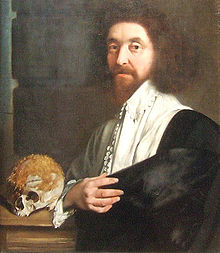| This article needs additional citations for verification. Please help improve this article by adding citations to reliable sources. Unsourced material may be challenged and removed. Find sources: "John Tradescant the Younger" – news · newspapers · books · scholar · JSTOR (December 2007) (Learn how and when to remove this message) |
| John Tradescant the Younger | |
|---|---|
 John Tradescant the Younger, attributed to Thomas de Critz John Tradescant the Younger, attributed to Thomas de Critz | |
| Born | 4 August 1608 Meopham, Kent, England |
| Died | 22 April 1662(1662-04-22) (aged 53) Lambeth, London, England |
| Nationality | English |
| Scientific career | |
| Fields | botany |
| Author abbrev. (botany) | Trad. |
John Tradescant the Younger ( /trəˈdɛskənt/; 4 August 1608 – 22 April 1662), son of John Tradescant the Elder, was a botanist and gardener. The standard author abbreviation Trad. is applied to species he described.
Biography
Son of John Tradescant the Elder, he was born in Meopham, Kent, and educated at The King's School, Canterbury. Like his father, who collected specimens and rarities on his many trips abroad, he undertook collecting expeditions to Virginia between 1628 and 1637 (and possibly two more trips by 1662, though Potter and other authors doubt this). Among the seeds he brought back to introduce to English gardens were great American trees including magnolias, bald cypress and tulip tree, and garden plants such as phlox and asters.
John Tradescant the Younger added his American acquisitions to the family's cabinet of curiosities, known as The Ark. These included the ceremonial cloak of Chief Powhatan, an important Native American relic. South Lambeth Road in Vauxhall was one of the boundaries of the Tradescant estate, where the collection was kept and Tradescant Road was laid out after the estate was built on in the 1870s and named after the family.
When his father died, he succeeded as head gardener to King Charles I and Queen Henrietta Maria, making gardens at the Queen's House, Greenwich, designed by Inigo Jones, from 1638 to 1642, when the queen fled the Civil War. He published the contents of his father's celebrated collection as Musaeum Tradescantianum—books, coins, weapons, costumes, taxidermy, and other curiosities—dedicating the first edition to the Royal College of Physicians (with whom he was negotiating for the transfer of his botanic garden), and the second edition to the recently restored Charles II. Tradescant bequeathed his library and museum to (or some say it was swindled from him by) Elias Ashmole (1617–1692), whose name it bears as the core of the Ashmolean Museum in Oxford where the Tradescant collections remain largely intact.

Tradescant died on 22 April 1662, aged 53, in South Lambeth. He was buried beside his father in the churchyard of St. Mary-at-Lambeth which is now established as the Garden Museum.
Legacy
He is the subject of the novel Virgin Earth by Philippa Gregory, sequel to Earthly Joys about his father. Tradescant is a character in Jeanette Winterson's novel "Sexing the Cherry."
The standard author abbreviation Trad. is applied to species he described.
Marriages and issue
| This section does not cite any sources. Please help improve this section by adding citations to reliable sources. Unsourced material may be challenged and removed. (September 2024) (Learn how and when to remove this message) |
- Jane Hurte, died 1634
- John, died age 19
- Frances, married Alexander Norman
- Ester (Hester) Pooks
Gallery
-
 Portrait by William Dobson, circa 1720
Portrait by William Dobson, circa 1720
-
 Tradescant's House, Lambeth
Tradescant's House, Lambeth
-
 Ester, his second wife, by Thomas de Critz. Ashmolean Museum, Oxford
Ester, his second wife, by Thomas de Critz. Ashmolean Museum, Oxford
Notes
- Anon. "Baptism of John Tradescant, Meopham Parish Church, 4 August 1608". Medway City Ark Document Gallery. Medway Council. Retrieved 17 September 2009.
- Moore, James J. (1878). The historical handbook and guide to Oxford: embracing a succinct history of the university and city from the year 912. Thomas Shrimpton and Son. ISBN 1437309445.
The Tradescant Collection was the most popular and curious show of the day, and attracted many visitors. It was named the Museum Tradescantianum, or Tradescant's Ark. Elias Ashmole lodged with Tradescant at Lambeth, and Tradescant bequeathed the Museum to him. When Ashmole gained possession of the Museum he added many varieties to it, including coins, MSS., medals, paintings, and the Library of Lilly, the celebrated astrologer, which he purchased for £50. Ashmole was the son of a saddler at Lichfield, born, according to his own statement, at near half an-hour after three o'clock in the morning, on the 23rd day of May, 1617. He was successively a solicitor in Chancery, an attorney in the Common Fleas a gentleman in the Ordnance (when Oxford was garrisoned by a royal army), an exciseman, a freemason, astrologer, botanist, chemist, anatomist, physician, and a learned herald. Heraldry seems to have been his forte, and astrology his foible. He was the author of the History of the Garter In 1669 he received the honour of "Doctor of Phisick" at Oxford, the diploma bemg presented by Dr. Yates, Principal of Brasenose College.
- "Kent".
- "Virgin Earth".
- Proctor, James. "Jeanette Winterson Biography". British Council Literature. British Council. Retrieved 2 September 2024.
References
- Leith-Ross, Prudence (1984). The John Tradescants: Gardeners to the Rose and Lily Queen. P. Owen. ISBN 0-7206-0612-8..
- MacGregor, Arthur, ed. (1983). Tradescant's Rarities: Essays on the Foundation of the Ashmolean Museum. Clarendon Press. ISBN 0-19-813405-3.
- Potter, Jennifer (2006). Strange Blooms: The Curious Lives and Adventures of the John Tradescants. Atlantic. ISBN 1-84354-334-6.
External links
- Tradescant Collection at the Ashmolean Museum
- Vauxhall Society
- Death of Hester Tradescant The story of Ashmole's obsession and the mysterious death of Hester Tradescant, widow of the younger John, told in the style of a modern newspaper article.